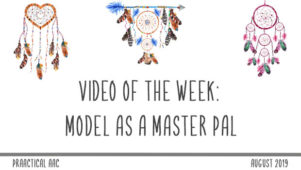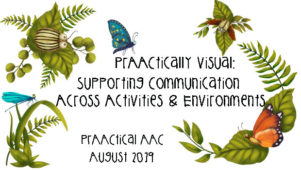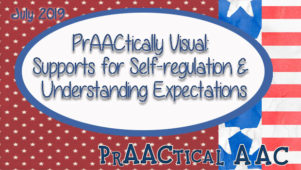Building AAC Facilitation Skills with Tabi Jones-Wohleber: MASTER PAL Training, Module 11 (Let the Child Lead)
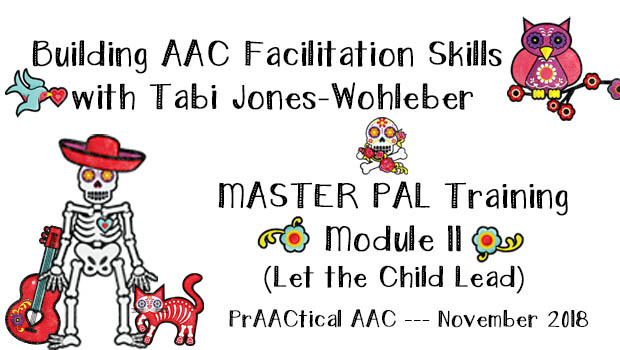
 Today, Tabi Jones-Wohleber shares the last module in the MASTER PAL training series, which provides tips and strategies for working with children who don’t yet demonstrate joint attention. This module should take 30-40 minutes to present. Join us next week as we do a final wrap-up with suggestions on using this training series in your AAC work.
Today, Tabi Jones-Wohleber shares the last module in the MASTER PAL training series, which provides tips and strategies for working with children who don’t yet demonstrate joint attention. This module should take 30-40 minutes to present. Join us next week as we do a final wrap-up with suggestions on using this training series in your AAC work.
:::::::::::::::::::::::::::::::::::::::::::::::::::::::::::::::::::::::::::::::::::::::::::::::::::::::::::::::
Model as a MASTER PAL
Module 11: Let the Child Lead
Facilitator Guidelines
It can be really difficult to get communication started with a child who does not demonstrate joint attention. This module explores tips and strategies for traveling with a child on their journey from preoccupation with seeking sensory input/inattention to learning, engaging, and communicating. Because learning emerges from meaningful social emotional experiences, letting the child lead can go a long way toward being invited into their world. Then learning can happen!
Here are some things you will need for this module.
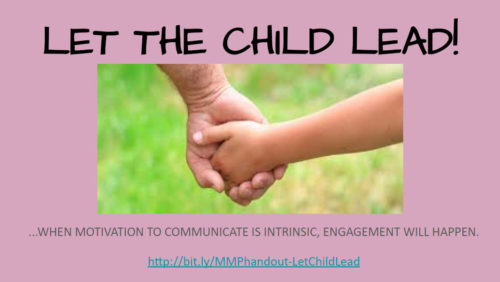
Warm-up Discussion: Embedded in Introduction (slides 8-9)
The Discourse
| Topics Addressed | Slide(s) | Talking Points / Examples |
| Title Slides | 1-2 | N/A |
| Communication Review | 3-7 | Review of Model as a MASTER PAL and AAC to ensure all participants are on the same page |
| Introduction
(no warm-up discussion) |
8-9 | Learning emerges from social / emotional experiences. Let that sink in. Contemplate what it means for the students with whom you work. What do the relationships in your classroom / school look like?
Fact of the matter is this; as humans we have to be invested in our learning for actual learning to occur. Without the relationship we may go through the motions, but that is compliance, not authentic learning. For students with complex needs, the skills we seek to teach can only be meaningful addressed when it comes from a place where the student is invested in the interaction around that skill. In order to achieve progress, the relationship is necessary to foster communication and learning. |
| The Science of Engagement | 10 | Dopamine release is the chemical process in our bodies that creates positive emotions. Dopamine release occurs after a workout, a successful performance, and other pleasurable activities. In addition to creating positive feelings, it also contributes to focus and motivation. This is the science behind the power of engagement. |
| 3 Types of Engagement | 11 | Definitions are provided on the slide for emotional, behavioral and cognitive engagement. The three types of engagement describe the whole person experience of engagement. One or more type of engagement may be present in an interaction.
This is a useful framework because engagement is often compromised when working with individuals with CCN for a variety of reasons:
Awareness of engagement as it relates to individual students is the first step in problem-solving how to improve engagement. |
| The Journey from Preoccupation, through Joint Attention & Emergent Communication, to Full Engagement | 12 | It is important to paint a picture that defines this journey:
|
| Fostering Joint Attention | 13 | Observation is a powerful tool, often left untapped. If a child is seeking tight spaces, perhaps we can create an interaction with a hug or shoulder squeeze. If the child is running fast, perhaps a game of chase will let us into his/her world. Imitating the child’s responses often catches him/her off guard. Perhaps it will provide an opening for them to notice us, maybe even follow our guidance. Or maybe they take note when we do it their way instead. Once we have his/her attention we have an opening to shape the interaction by creating reciprocity, and eventually meaningful and purposeful exchanges. |
| The Eyes Don’t Lie | 14 | When students don’t have an effective form of communication or have difficulty engaging on our terms, where they look and what they look at tells much. A look and facial expression can convey “I like that, I don’t understand, I’m curious, I’m fearful, I’m excited”. Validate these cues with talk alouds to establish and extend interactions (Oh, you see the storm; You’re surprised Ms. Mary is here, etc). These are the interactions life is made of, and very often will provide opportunities for authentic interactions. |
| More tips for Fostering Joint Attention | 15 | Explained on the slide. |
| Food for Thought | 16 | Explained on the slide. |
| Videos (pending) | 17 | Video: Student-Directed Shared Reading
Play the segment from 1:49-4:02. This student is using a switch by his head to request “Let’s read more.” On the third page, his visual attention lingers on the page. The teacher patiently allows him to look and responds to his interest by lifting this flap 3 times. She does not prompt him to “turn the page”, but follows his lead and interest to explore the book! |
| MASTER PAL, in Summary (pending video approval) | 18 | Video: Modeling with Connor
The interaction in this video encompasses many of the components explored in MASTER PAL. Show the video 1-3 times and allow participants to note the nature of the interactions between the student, teacher, and SLP. |
| Let’s Re-Cap | 19 |
|
Supplemental Handouts
- Hanen Center: OWL (Observe, Wait, Listen)
Video Links
Interactive Activities/Discussions: NONE for this Module
Extension Resources
- Angelman Syndrome Foundation –
- Communication Training Series: Module # 23, Shared Reading
- Project Core – Shared Reading: An Instructional Routine that Promotes Communication
Filed under: Featured Posts, PrAACtical Thinking
Tagged With: child-led therapy, MASTER PAL, Tabi Jones-Wohleber
This post was written by Carole Zangari

